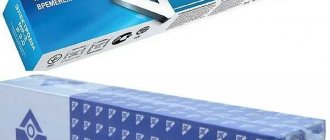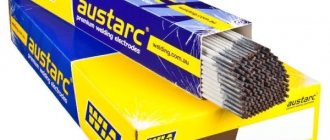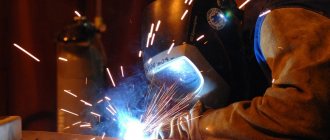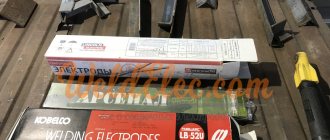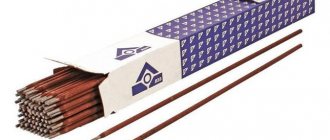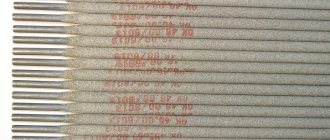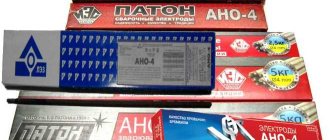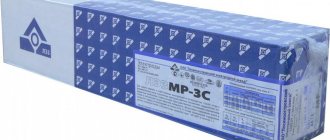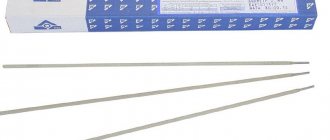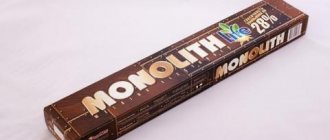A welding electrode is a metal rod capable of conducting electricity. There are several types of welding electrodes, melting and non-melting. The consumable electrodes are coated with a special coating - coating, which consists of various components.
The main task of electrode coating is to protect the weld pool from external influences, ensure uninterrupted burning of the arc and create a seam that meets special characteristics. Therefore, depending on the welding tasks, electrodes are produced with different coatings: rutile, having a basic, cellulose and acid coating.
Types of electrode coating: basic, rutile, acidic, cellulose
Answering the question of how rutile electrodes differ from electrodes with a basic coating, one can understand that the main difference is in the composition of the coating. The filler in this case is various substances, the percentage of which varies greatly for electrodes with different coatings.
According to the type of coating, electrodes are divided into the following:
- Acidic - letter designation (A);
- With rutile coating (P);
- Having a basic coating (B);
- With cellulose coating (C);
- Having a mixed type of coating (two letters in the designation);
- Electrodes with other types of coatings (P).
Mixed types of coatings include electrodes coated with:
- Acid-rutile coating;
- Rutile-cellulose coating;
- Rutile base coat.
The characteristics of the electrodes largely depend on the type of coating. Therefore, it is very important to understand where it is best to use electrodes with the above four coatings: basic, rutile, cellulose and mixed.
Types, composition and characteristics of various types of electrode coatings
The chemical composition of the coating and its thickness have a decisive influence on the parameters of the welding process - the stability of the electric arc, the characteristics of the transition of the rod material into the weld pool, the viscosity of the slag and molten metal, etc.
Consumable electrodes
Consumable electrode for welding: 1 - rod, 2 - transition area, 3 - brand of electrode, 4 - coating.
Thickness _ In accordance with GOST 9466-75, based on the thickness determined by the ratio of the outer diameter of the electrode (D) to the diameter of its rod (d), coatings are divided into the following types depending on the D/d ratio:
- thin - D/d < 1.2 - (indicated by the letter “M”);
- average - 1.2 < D/d < 1.45 - (“C”);
- thick - 1.45 < D/d < 1.8 - (“D”);
- especially thick - D/d > 1.8 - (“G”).
Chemical composition . Depending on the chemical composition, the following types of electrode coatings are distinguished:
- sour - designated A (A);
- main - B (B);
- cellulose - C (C);
- rutile - P (R);
- mixed type - (RB, RA, RC, etc.);
- other types of coatings - P.
In brackets are the designations according to the European standard DIN EN 499 (C - cellulose, A - acid, R - rutile, B - basic). The designation RR, which is sometimes found, means “rutile thick.”
Acidic coatings . Acidic coatings, consisting primarily of iron and manganese ores (oxides of iron and manganese), release large amounts of oxygen into the arc, which increases its temperature and reduces the surface tension of the molten metal, making it very fluid. This makes it possible to increase welding speeds, but at the same time increases the risk of undercuts. In addition, the presence of toxic manganese oxides in the coating makes welding with such electrodes unsafe for the health of the welder. Therefore, pure acid coatings are used to a limited extent nowadays. They have been replaced by mixed rutile acid (RA).
Rutile coatings . Rutile coatings consist primarily of natural rutile concentrate (titanium dioxide TiO2), silica (granite, feldspar, mica), calcium and magnesium carbonates, and ferromanganese. Electrodes with rutile coating ensure the transfer of the metal rod into the bath in small or medium drops and are characterized by quiet melting with a small amount of spatter. The seam has a fine pattern, the slag is easily separated from the weld metal.
A very important feature of rutile-coated electrodes is the ease of arc re-ignition due to the presence of TiO2. In this case, it is not even necessary to remove the film in the electrode crater, since it (with a sufficiently high TiO2 content) has semiconductor conductivity and ensures ignition of the arc without contact of the rod with the base metal. This advantage of rutile coatings creates great convenience when working with short seams, when it is necessary to frequently interrupt the arc.
Electrode with rutile coating: 1 - metal rod, 2 - rutile coating, 3 - slag film in the electrode crater, 4 - product.
Rutile coatings are less harmful to the welder's health than others.
In addition to pure rutile coatings, mixed ones are widespread: rutile-cellulose type (RC), rutile-basic (RB), rutile-acid (RA), which also have good technological properties. Electrodes with pure rutile and mixed coatings (MR-3, ANO-21, ANO-4, OZS-6, etc.) can weld seams in almost any position.
Basic coatings . Basic type coatings consist mainly of magnesium and calcium carbonates (dolomite, marble, magnesite). Fluorspar (CaF2) is added to them as a slag diluent. The latter degrades AC performance, so pure base coated electrodes are designed for DC operation only. However, mixed types, which have a lower fluorspar content, can also be used for AC operation. The transfer of metal into the weld pool occurs in medium and large drops, the molten metal becomes viscous.
Unlike other coatings, the resulting gas-protective environment of mineral origin, consisting mainly of CO and CO2, is devoid of hydrogen, which leads to the formation of cold cracks in the deposited metal. Due to the low hydrogen content, so-called low-hydrogen electrode coatings are made on the basis of the main coating.
The weld metal welded with base-coated electrodes has increased ductility. These electrodes are used to weld critical structures.
Electrodes with a basic coating can be used to make seams of any spatial position, however, due to the increased viscosity of the metal, the seams are convex and rough.
Basic type coatings are highly hygroscopic, so they need to be stored dry. The main coating has such popular electrodes as UONI 13/45 and UONI 13/55.
Cellulose coatings . Cellulose coatings consist of cellulose, organic resins, ferroalloys, talc and other substances. The main feature of combustion of coatings with organic substances in an arc is the formation of a large amount of protective gases and very little slag. This makes them convenient for welding vertical seams (slag does not flow down).
The disadvantages of cellulose-coated electrodes include a significant amount of spatter during welding and reduced ductility of the weld metal, due to a large (relative to other coatings) amount of hydrogen generated during the combustion of organic components.
Iron powder coatings . Sometimes iron powder is added to the coating. Electrodes with iron powder provide increased productivity, which is why they are sometimes called “high-performance electrodes.” Iron powder increases the penetration power of the welding arc and ensures high-quality welding of butt joints with irregular or increased gaps - even in the absence of backing plates. In addition, it improves arc re-ignition.
If the coating contains more than 20% iron powder, the letter Zh is additionally introduced into its designation. For example, the designation RZh means “rutile with iron powder.” An example of an electrode with iron powder in the coating is ANO-1.
The chemical composition of the coating and its thickness have a decisive influence on the parameters of the welding process - the stability of the electric arc, the characteristics of the transition of the rod material into the weld pool, the viscosity of the slag and molten metal, etc.
Consumable electrodes
Consumable electrode for welding: 1 - rod, 2 - transition area, 3 - brand of electrode, 4 - coating.
Thickness _ In accordance with GOST 9466-75, based on the thickness determined by the ratio of the outer diameter of the electrode (D) to the diameter of its rod (d), coatings are divided into the following types depending on the D/d ratio:
- thin - D/d < 1.2 - (indicated by the letter “M”);
- average - 1.2 < D/d < 1.45 - (“C”);
- thick - 1.45 < D/d < 1.8 - (“D”);
- especially thick - D/d > 1.8 - (“G”).
Chemical composition . Depending on the chemical composition, the following types of electrode coatings are distinguished:
- sour - designated A (A);
- main - B (B);
- cellulose - C (C);
- rutile - P (R);
- mixed type - (RB, RA, RC, etc.);
- other types of coatings - P.
In brackets are the designations according to the European standard DIN EN 499 (C - cellulose, A - acid, R - rutile, B - basic). The designation RR, which is sometimes found, means “rutile thick.”
Acidic coatings . Acidic coatings, consisting primarily of iron and manganese ores (oxides of iron and manganese), release large amounts of oxygen into the arc, which increases its temperature and reduces the surface tension of the molten metal, making it very fluid. This makes it possible to increase welding speeds, but at the same time increases the risk of undercuts. In addition, the presence of toxic manganese oxides in the coating makes welding with such electrodes unsafe for the health of the welder. Therefore, pure acid coatings are used to a limited extent nowadays. They have been replaced by mixed rutile acid (RA).
Rutile coatings . Rutile coatings consist primarily of natural rutile concentrate (titanium dioxide TiO2), silica (granite, feldspar, mica), calcium and magnesium carbonates, and ferromanganese. Electrodes with rutile coating ensure the transfer of the metal rod into the bath in small or medium drops and are characterized by quiet melting with a small amount of spatter. The seam has a fine pattern, the slag is easily separated from the weld metal.
A very important feature of rutile-coated electrodes is the ease of arc re-ignition due to the presence of TiO2. In this case, it is not even necessary to remove the film in the electrode crater, since it (with a sufficiently high TiO2 content) has semiconductor conductivity and ensures ignition of the arc without contact of the rod with the base metal. This advantage of rutile coatings creates great convenience when working with short seams, when it is necessary to frequently interrupt the arc.
Electrode with rutile coating: 1 - metal rod, 2 - rutile coating, 3 - slag film in the electrode crater, 4 - product.
Rutile coatings are less harmful to the welder's health than others.
In addition to pure rutile coatings, mixed ones are widespread: rutile-cellulose type (RC), rutile-basic (RB), rutile-acid (RA), which also have good technological properties. Electrodes with pure rutile and mixed coatings (MR-3, ANO-21, ANO-4, OZS-6, etc.) can weld seams in almost any position.
Basic coatings . Basic type coatings consist mainly of magnesium and calcium carbonates (dolomite, marble, magnesite). Fluorspar (CaF2) is added to them as a slag diluent. The latter degrades AC performance, so pure base coated electrodes are designed for DC operation only. However, mixed types, which have a lower fluorspar content, can also be used for AC operation. The transfer of metal into the weld pool occurs in medium and large drops, the molten metal becomes viscous.
Unlike other coatings, the resulting gas-protective environment of mineral origin, consisting mainly of CO and CO2, is devoid of hydrogen, which leads to the formation of cold cracks in the deposited metal. Due to the low hydrogen content, so-called low-hydrogen electrode coatings are made on the basis of the main coating.
The weld metal welded with base-coated electrodes has increased ductility. These electrodes are used to weld critical structures.
Electrodes with a basic coating can be used to make seams of any spatial position, however, due to the increased viscosity of the metal, the seams are convex and rough.
Basic type coatings are highly hygroscopic, so they need to be stored dry. The main coating has such popular electrodes as UONI 13/45 and UONI 13/55.
Cellulose coatings . Cellulose coatings consist of cellulose, organic resins, ferroalloys, talc and other substances. The main feature of combustion of coatings with organic substances in an arc is the formation of a large amount of protective gases and very little slag. This makes them convenient for welding vertical seams (slag does not flow down).
The disadvantages of cellulose-coated electrodes include a significant amount of spatter during welding and reduced ductility of the weld metal, due to a large (relative to other coatings) amount of hydrogen generated during the combustion of organic components.
Iron powder coatings . Sometimes iron powder is added to the coating. Electrodes with iron powder provide increased productivity, which is why they are sometimes called “high-performance electrodes.” Iron powder increases the penetration power of the welding arc and ensures high-quality welding of butt joints with irregular or increased gaps - even in the absence of backing plates. In addition, it improves arc re-ignition.
If the coating contains more than 20% iron powder, the letter Zh is additionally introduced into its designation. For example, the designation RZh means “rutile with iron powder.” An example of an electrode with iron powder in the coating is ANO-1.
Electrodes with basic coating
The basis of this coating is fluoride compounds. In terms of its chemical composition, the metal deposited with electrodes with a basic coating is very close to mild steel. The welding seam is characterized by high levels of impact strength, strength and ductility, due to the low content of electrodes, non-metallic inclusions, gases, and also harmful impurities in the coating composition.
Electrodes with a basic coating are somewhat inferior to other electrodes in terms of sensitivity when welding rusty metals. Also, during the welding process, pores often form on the seams. Electrodes with a base coating are quite sensitive to moisture, so they quickly become damp, requiring calcination before use.
Purpose of welding electrodes
The role of electrodes is reduced to forming an arc in electric arc welding. The quality of the electrodes directly affects the efficiency and results. How stable the arc will be, how deeply the metal will heat up, how easy it is to ignite the arc and other nuances during welding are determined by the choice of electrodes. They have to:
- maintain a stable arc during operation;
- melt evenly;
- form a neat seam with the desired chemical composition;
- create conditions to minimize the splashing of hot metal;
- help improve the efficiency of welding work;
- ensure joint strength;
- have a low degree of toxicity.
In addition, the slag that is formed during the welding process should be easily removed.
Rutile coated electrodes
Rutile electrodes contain the highest percentage of natural titanium dioxide (rutile concentrate) in the coating composition. The weld seam obtained using rutile electrodes has less cracking, and its characteristics correspond to semi-quiet and calm steels.
Compared to other electrodes, rutile electrodes have many more advantages. First of all, these include easy slag separation and stable maintenance of the welding arc. When welding with rutile-coated electrodes, the metal spatters less, and the electrodes themselves are not so susceptible to moisture. They cook consistently even on poorly prepared, rusty metals.
Classification of electrodes for manual arc welding
When considering different types of electrodes for manual arc welding, attention should be paid to the fact that various coatings can stabilize the resulting arc during combustion. All types of rod coating have their own characteristics, which should be taken into account when considering the types of electrodes for manual arc welding. The same brands can be produced by different manufacturers. It is worth considering that the quality of consumables may vary significantly.
The purpose of the electrodes can be very different. Based on this criterion, the following classification of manual arc welding electrodes is carried out:
- Alloyed metals have become quite widespread, since the addition of various chemicals significantly improves their performance characteristics. Some chemicals can significantly increase the heat resistance of a metal. For such alloys, electrodes are used, which are marked with the letter “T”.
- For welding steels that have a low concentration of impurities, design options are used, which are marked with the letter “U”. In addition, such electrodes for manual arc welding are suitable for metal compounds with an average carbon concentration. The achieved tensile strength value is 600 MPa.
- Structural steels have also become very widespread. They also contain alloying elements. The tensile strength in this case is 600 MPa.
- In some cases, metal may be soldered onto the surface. Metal can have exceptional performance qualities. For this case, a design option is suitable, which is designated by the letter “N”.
- There are electrodes on sale designed for steels with a high concentration of alloying elements.
- A separate group includes steels that have high ductility properties. It is quite difficult to work with such a material, so they began to produce electrodes for aluminum or other similar alloys. The marking indicates the letter “A”.
Types of electrodes for welding
The diameters of electrodes for manual arc welding can differ significantly, which is due to the characteristics of the work being performed. Classification is also carried out according to the thickness of the coating being created. The following types of electrodes are distinguished:
- With a thin coating. When designating, the letter “M” is used. As a rule, in this case the surface layer is about 20% (the indicator is taken from the total diameter).
- With medium coating thickness. When designating, the letter “C” is indicated. In this case, a layer is applied whose thickness is 45% of the diameter of the rod used during manufacture.
- The thick coating is 80% of the diameter and is marked with the letter “D”.
- There are also particularly thick versions, which are designated by the letter “G”. In this case the thickness is more than 80%.
Do not forget that electrodes may have restrictions on their use and position during work. An example is that some substances have increased fluidity, and it will be difficult to carry out work near the ceiling surface. In order to quickly determine the purpose of the electrodes for manual arc welding, a certain marking scheme is used:
- 1 – design options that can be used in almost any position. This is due to the fact that the coating used retains its shape and is not too fluid.
- 2 – can be used in almost all positions, with the exception of work with a vertical position of the tool used.
- 3 – these electrodes are designed for horizontal and vertical use, ceiling position is excluded
- 4 – electrodes for manual arc welding, which can only be used in a horizontal position.
Different brands of electrodes for welding
It is worth considering that different countries have different labeling standards. On sale there are electrodes for manual arc welding from domestic and foreign manufacturers, the classification of which may differ significantly.
Acid coated electrodes
The composition of the coating of acid-coated electrodes contains the highest percentage of silicon, manganese and iron oxides. Acid-coated electrodes can be used for welding with both alternating and direct currents.
However, electrodes with this type of coating have one significant drawback, the formation of so-called “hot cracks”. Acid electrodes do not form pores when welding rusty metal, or, for example, when the welding arc is significantly extended.
Types and composition of coating of welding electrodes
For manual arc welding, electrodes are used, consisting of rods 25-45 cm long, on the surface of which a layer of special coating is applied. There are several classes of them on the market:
- stabilizing . They contain elements that perfectly ionize the welding arc. In most cases, the coating is applied to the rods in a thin layer - thin-coated electrodes;
- protective _ The covering is made from a mixture of different materials. The main task of the composition is to protect the melt zone from exposure to atmospheric air. In addition, they promote stable arc burning, refine and alloy the seam;
- magnetic . They are applied to the rod directly during welding. Spraying is carried out under the influence of electromagnetic forces that are formed between a live wire and ferrimagnetic powder poured into a special hopper. The wire or rod is fed into the welding zone through this hopper.
There are the following main types of electrode coatings:
- acid ore . They contain oxides of manganese and iron, silica and a lot of ferromanganese. To create a protective environment, organic substances are included in the composition - starch, wood flour, cellulose and others;
- rutile _ They are becoming increasingly popular thanks to the development of technologies for the extraction of rutile minerals. Its main component is titanium dioxide (TiO2). In addition to rutile, coatings also contain other elements: potassium and magnesium carbonates, ferromanganese, silica;
- calcium fluoride . The composition includes calcium and magnesium carbonates, ferroalloys and fluorspar;
- organic . The composition contains mainly organic compounds. Most often, oxycellulose is used with the addition of slag-forming materials, deoxidizers and alloying additives.
Cellulose coated electrodes
The coating of cellulose electrodes consists half of organic components, most often cellulose. A weld deposited with cellulose electrodes contains a high percentage of hydrogen. When welding with cellulose-coated electrodes, a uniform back bead is formed.
Electrodes with all of the above coatings are intended for welding low-alloy and carbon steels. All of them are used in order to obtain welded joints that differ in some special characteristics that are required by the operating conditions of metal structures.
Share on social networks
Welding wire for electrode rods
For manual arc welding, special grades of welding and surfacing wire are used. GOST 2246 provides for about 80 grades of steel welding wire with different contents of chemical elements. Depending on this, there are wires made from low-carbon steel (grades Sv-08, Sv-08A, Sv-08AA, Sv-08GA, Sv-10GA, Sv-10G2), from alloy steel (grades Sv-08GS, Sv-08G2S, Sv-18KhGS, etc.) and from high-alloy steel (grades Sv-12Kh11NMF, Sv-10Kh17T, Sv-06Kh18N9T, etc.).
Steel welding wire, manufactured in accordance with the requirements of GOST 2246, is used for the manufacture of electrodes and is used for all types of fusion welding. For manual arc welding with coated electrodes , wire with a diameter of 1.6 to 6 mm is used.
